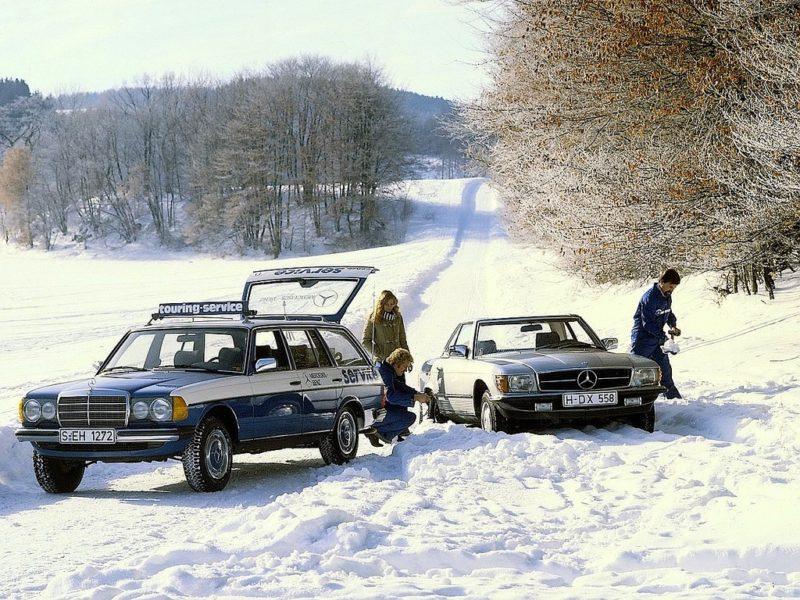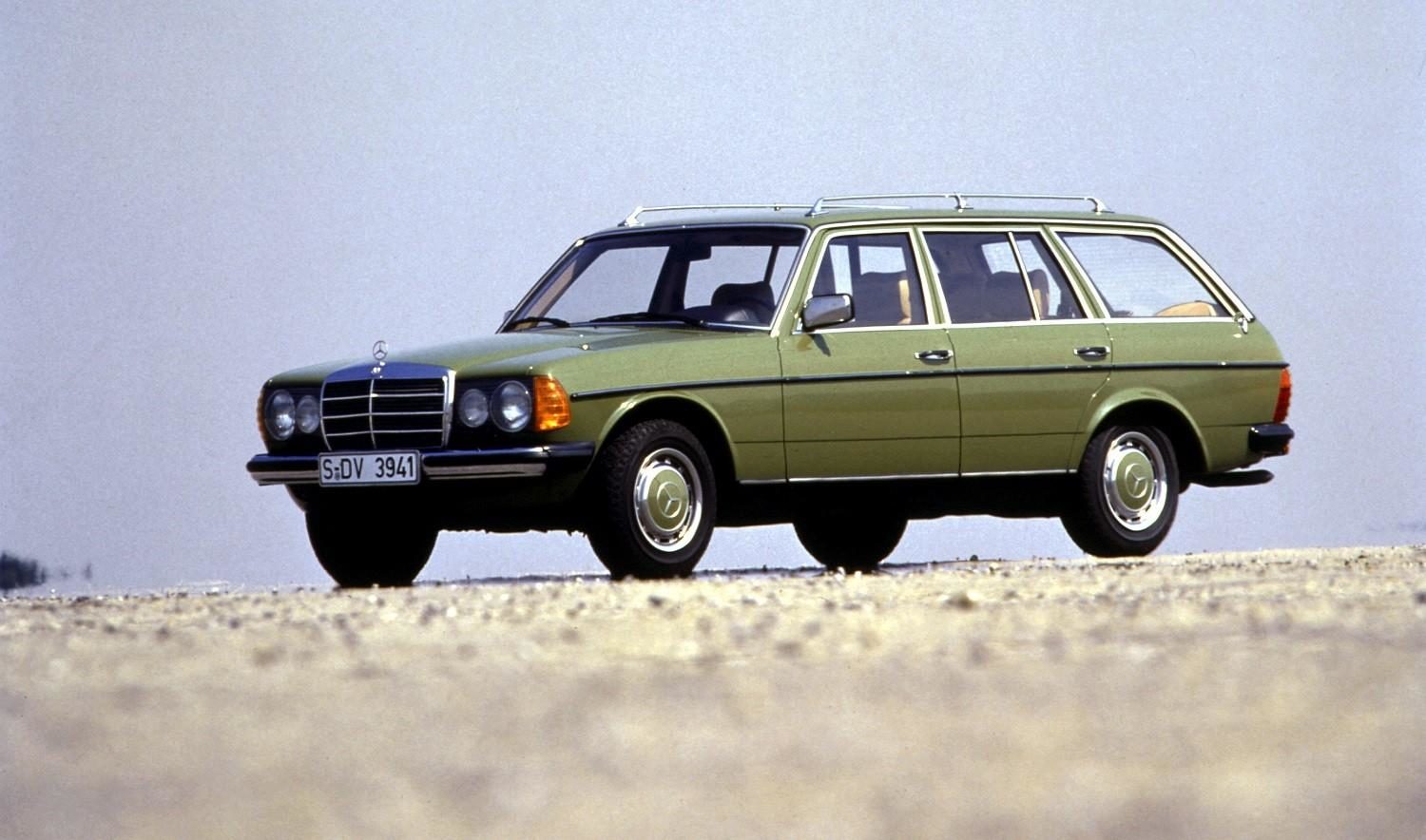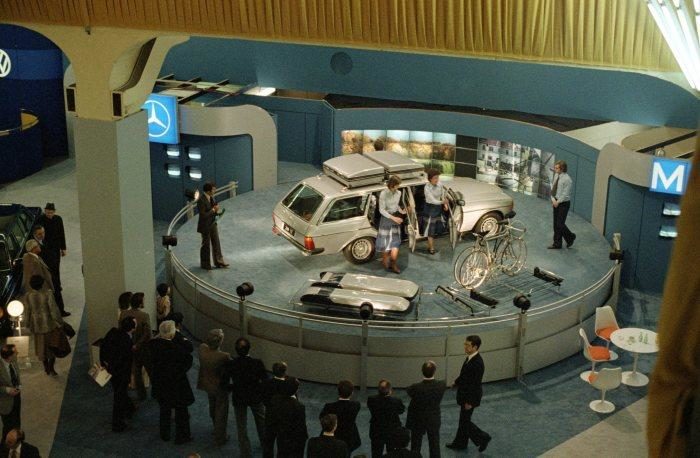In 1977 the world became acquainted with the station wagon variant of the W123: the Mercedes-Benz S123. The T-model will be made public at the IAA in Frankfurt. Like the W123 sedan, the presentation of the 'Mercedes-T' unleashes high demand, leading to long delivery times. Production starts in Bremen in 1978. It is the beginning of an era in which no one at Mercedes-Benz is in any doubt about the importance of a Combi variant within the model range.
Three years after the Mercedes-Benz management gives the green light for the development of a luxury five-door station wagon, production starts. In May 1978 in the old Borgward factories in Bremen-Sebaldsbrück, series production of the W123 Kombi is started, which comes with a smaller engine range than the sedan brother. The Mercedes-Benz S123 – the first station developed by Mercedes-Benz itself – debuts with a delivery program consisting of the 230 T, the 250 T, the 280 TE, the 240 TD and the 300 TD. The smallest six-cylinder of the T models (the T stands for Touristik and Transport) is the first to clear the field. In August 1982 the variant propelled by the M123 V25 engine came to an end.
Extension
Meanwhile, the delivery program on the other hand has expanded. In 1980, the T model series welcomed the 200 T and the 230 TE. The 300 TD Turbodiesel also sees the light of day. The basis is formed by the trusted OM 617 five-cylinder diesel engine. This will be expanded with the 'Garret Air Research' turbocharger. The engine – officially called OM 617 D 30 A – produces 125 horsepower and accelerates to a top speed of 165 kilometers per hour. A 4-speed automatic transmission is coupled to the engine. Initially, the Turbodiesel was not qualitatively calculated on the European speed standards, so that the necessary start-up problems arose.
Transport and leisure function
The Mercedes-Benz S123 shares many technical components with the sedan. The transport and leisure function is demonstrated by the large amount of (variably divisible) luggage space and the standard roof rails (from the summer of 1978), which are elegantly arranged on the long body of the Mercedes station be confirmed. Bearing in mind Mercedes-Benz, there are of course numerous options available. Functionally, the possibility to expand the S123 with two child seats is striking. In addition, the new Mercedes stations come with hydropneumatic level control as standard on the rear.
High level finish
From the outset, Mercedes-Benz positions the S123 as “Edelkombi”. The emphasis is placed on lifestyle and quality. Not a single piece of bare metal is visible in the Benz and the finish is of a high standard on all levels. It contributes significantly to the image of luxury Combi variants. An image that has already been fruitfully nourished thanks to, among other things, the Break/Family models from Peugeot and the combis from Volvo. In any case, the customer appreciates the arrival of the Mercedes-Benz S123.
Almost 200.000 units built, 250 T now the most wanted
A total of 1978 units of the Edelkombi were built from May 1986 to January 199517 1980. The 230 TE, introduced in 250, is the most sold. The first “einggestellte” 123 T the most wanted. Whichever variant rolls off the production line in Bremen: the SXNUMX, which, in cosmetic and technical terms, receives the same retouches as the sedan (and to a slightly lesser extent the coupé) during its lifetime, is the definitive founder of a new body style at Mercedes-Benz. benz. Because the station models have been indispensable for the German brand since the second half of the XNUMXs.
All images are from Daimler AG













@Niels.
That 240D that I, by jacking it up, gave a royal hole in the rusted box girder, was a 5 cylinder. I could be wrong but in my memory a 200D was a 4 cylinder, the 240D was a 5 cylinder and the 300D was a 6 pitter. So out of my head. Somewhere in the past they have already made a grab in the engine program and those power sources were spooned into the Unimogs. The far too low power of, for example, the 2,2L petrol version ensured that the top speed of a 404S was below 100 km/h and acceleration could be measured with the calendar.
diesel 4 cylinder: 200d 4 cyl (2 litre), 220d 4 cyl (2,2 litre), 240d 4 cyl (2,4 litre), 300d 5 cyl 3 liter was a 240d engine with an extra cylinder added
petrol: 200 (2 liter 4 cyl), 220 (2,2 liter 4 cyl, 250 2.5 liter 6 cyl, 280 2,8 liter 6 cyl
The model series is not called S123, but W123., and apart from the rust problem was still a real Mercedes.
Dear Wim,
The sedan series is called W 123, the combi, however, S 123
I drove almost 300.000 km with the 300D bjr 1979 Lorschinger version .... the front chambers broke after about 100.000 km so 2x engine overhaul, would have been nice of mercedes if they had told that a few years later this had changed but no horn …… and rust pfff especially under that tough tectyl plastic layer .. ... despite standing inside and keep it clean…. Those chairs were not for a meter, for me as a mile-eater but an ASS chair put in it …… no party number from Mercedes
They were way ahead of their time. Beautiful car, drove wonderfully but unfortunately they were, which was outrageous by the way, totally bio-degradable. (except the MB-Tex)
Three winters in Whistler and the holes fell. They sold quite well for such an expensive car. It's a rarity that you still see one. Unfortunate. I liked the seat behind the wheel
great, but even the chair was short-lived. Oh well, c'est la vie.
Greetings to all readers, mv and so sweetly to the rest of the alphabet.
Depicting your new station as a breakdown service car next to your own coupe model as a press photo (apparently with breakdown . . . . )
What I don't understand about luxury cars in those days is that fog and reversing lights still dangle under the bumper like a kind of Halfords accessory.
Why not directly included in the design?
At that time, it had already become a kind of standard in the luxury segment.
Garrett, with double T. . ..
Some explanation about the engines would have been useful.
I'm not that familiar with the Benzen, and have no idea which one was a 4 pips, which was a 6, etc
Never understand the name at MB
In the beginning they were not sold well here in the Netherlands, according to a seller of a large Mercedes Benz dealer!
I once had to jack up a 240D. Unexpectedly it suddenly started to 'crack' and the jack was in the box girder. Much more rusted than could have been estimated beforehand. The engine was super but the body was well eaten by the brown plague. Sin
I first had a 123 station 240D and then a W115 240D for a long time
The 123 distinguishes itself from its predecessor by a lot of double hidden sheet metal. Once the rust is in it, it becomes a hopeless undertaking to restore it properly.
Furthermore, the station is a fine car of which a lot have driven around in NL.
The costs of parts and maintenance are (and were) unfortunately exaggerated.
Oh yes, I do remember the introduction of the T. Extremely shocking back then. "Mercedes with a station wagon, where does that go?" Well for every sub-niche a model in the range, such as Mercedes now has!
I think it is a nice car to see, not immediately beautiful but characteristic, just like the sedan. I have driven the 200d sedan, terribly slow device. Was literally as 'fast' as an ugly duck! Both in acceleration and top speed. Was a bit more luxurious than a duck, that is.